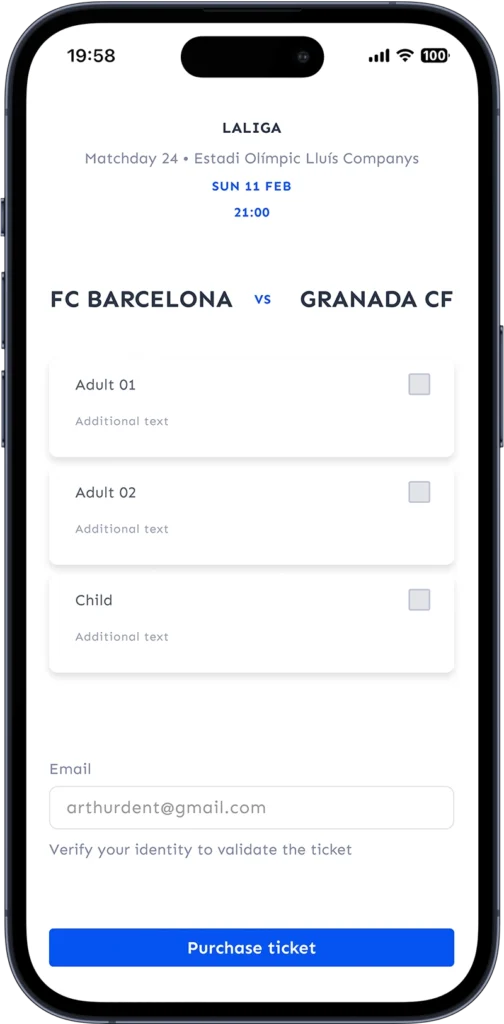Secure Access with a Simple Gesture
At TruCrowd, we’re integrating contactless palm recognition to streamline event access control, reduce queues, and provide a frictionless experience for attendees. With palm recognition, you gain a reliable, privacy-friendly, and secure method to verify identities, ensuring that every entry point is both efficient and trustworthy.
Palm recognition offers a robust solution. By analyzing the unique patterns of an individual’s palm, this technology provides a contactless and hygienic method of verification. Users simply present their palm to a standard camera—no physical contact or specialized equipment required.
This approach not only enhances security but also respects user privacy. Since palm images are rarely shared publicly, and the act of presenting one’s palm is a deliberate gesture, it ensures user consent and minimizes data misuse risks. Moreover, the system operates effectively even when small parts of the hand are covered, and its accuracy surpasses many traditional biometric methods.
process
How does it work?
1
Purchase tickets as always
TruCrowd’s solution integrates seamlessly with any existing ticketing system using a simple API. Imagine it’s just like a payment gateway during checkout – no disruption to your current process as fans skip tedious identity forms!
- Integrates with existing ticketing systems
- Well-documented REST API
- Existing access infrastructure

2
Make a photo of your palm
Before the event, fans verify identity and make a photo of their palm using web based application. It is as simple as taking a selfie and can be done with a smartphone or computer camera.
- Remote palm registration
- Works with standard smartphone or computer camera
- Hygienic and contactless
3
Ticketless biometric access control
On the day of the event, fans simply raise their hand toward the camera. No ticket needed. Their palm is matched with registered data in seconds. Privacy (deliberate gesture) + no chance of spoofing.
- No phone or paper needed
- Fully contactless
- Powered by Innovatrics' palm recognition algorithm
Benefits
What's the value of contactless palm access control?
Eliminate Ticket Fraud
Palm prints are unique and tied to real people. No more shared tickets or fake IDs slipping through.
Frictionless Entry
Fans move through gates faster. No need to scan anything—just raise a hand and walk in.
Works with What You Have
The system runs on standard cameras and devices. No need for custom hardware or expensive installations.
Built Around Privacy
Biometric data stays secure and local. Fans opt in, and palm images aren’t shared or stored in open systems.
Monetise Ticket Aftermarket
By tying tickets to identity, all transfers and resales can occur exclusively under your control.
FAQs about event check-in with palm recognition
We bring you answers to operational questions on the use of contactless palm access control.
- Does palm scanning work for children?
- Is the accuracy consistent across different skin tones?
- What if someone has unusually large or small hands?
- Does it work if the hand is dirty, scratched, or has a plaster?
- What are the camera requirements for palm scanning?
- How is GDPR compliance handled when collecting biometric data?
Does palm scanning work for children?
Yes. Our system is capable of recognizing children’s palms from around the age of 1. As children grow, minor changes in their palm structure may slightly reduce accuracy, but the algorithm is designed to handle varying palm sizes. Growth-related changes have not shown to significantly affect performance.
Is the accuracy consistent across different skin tones?
Yes. The palm scanning algorithm was trained on a balanced dataset that includes a wide range of skin tones and ethnic backgrounds. Smaller-scale tests have not shown any significant bias, and we continue to evaluate performance across demographics through larger-scale studies to ensure fairness and reliability.
What if someone has unusually large or small hands?
No problem. The algorithm is size-agnostic. It focuses on the internal palm patterns rather than the physical dimensions. Palm size or shape does not negatively impact accuracy or matching performance.
Does it work if the hand is dirty, scratched, or has a plaster?
Yes, it still works. The algorithm is robust enough to handle minor dirt, scratches, or even a small plaster, as long as most of the palm is clearly visible. Accuracy may only drop if large parts of the palm are fully covered.
What are the camera requirements for palm scanning?
Palm scanning works on most standard smartphone and laptop cameras. Minimum resolution needed is 800×600, and the camera should be able to focus clearly from a distance of 30–40 cm. Even older smartphones (10+ years) and basic laptop webcams have been tested successfully, though performance may vary slightly in poor lighting conditions.
How is GDPR compliance handled when collecting biometric data?
Palm images and templates are biometric data and therefore subject to strict GDPR safeguards. This includes voluntary and informed consent, data minimisation, and encryption. Compared to facial recognition, palm biometrics are often seen as less intrusive, as palms are generally perceived as less personally identifiable. Our software is provided as a toolkit that customers host themselves, ensuring they can align deployment with their specific compliance requirements.



